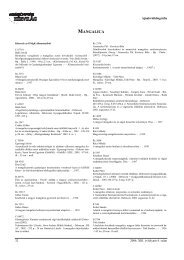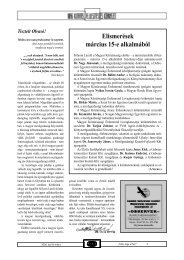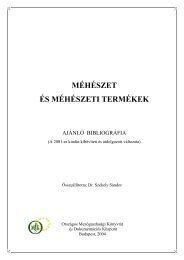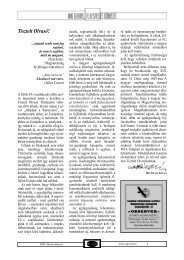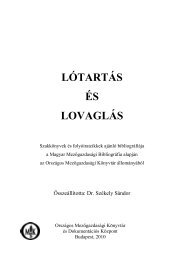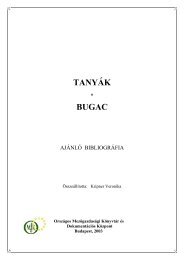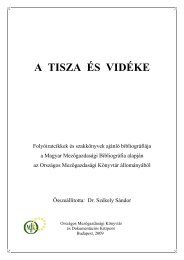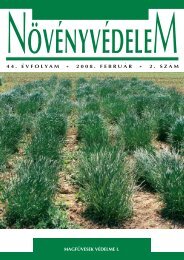hUNGARiAN AGRicUltURAl RESEARch
hUNGARiAN AGRicUltURAl RESEARch
hUNGARiAN AGRicUltURAl RESEARch
You also want an ePaper? Increase the reach of your titles
YUMPU automatically turns print PDFs into web optimized ePapers that Google loves.
Among our registered varieties<br />
that can adapt well to extreme<br />
weather, several varieties of Gaillardia<br />
pulchella is also worthy of note.<br />
In addition to their drought tolerance,<br />
they – contrary to the previously<br />
used varieties widespread in<br />
home gardens – are suitable for<br />
flower beds due also to their round<br />
shape and great flower mass. Red,<br />
yellow and bicolour varieties were<br />
created, which have gained international<br />
recognition as well.<br />
Diverse breeding practices<br />
The most important factor is the<br />
native area (original place of growth)<br />
of the breeding material. The use of<br />
the right breeding material has often<br />
proved to be successful for the<br />
purposes of improving drought<br />
tolerance of Hungarian varieties,<br />
such as in the case of Alcea biennis<br />
growing wild in Hungary or<br />
Rudbeckia hirta indigenous in the<br />
North American prairies.<br />
In many cases, for instance in<br />
those of Rudbeckia hirta and<br />
Cosmos sulphureus, the method of<br />
polyploidization was effective.<br />
Varieties improved this way show<br />
increased tolerance to various stress<br />
factors (heat, drought, extreme<br />
cold) and, at the same time, comply<br />
with the other main objective of<br />
breeding: they flower for a longer<br />
time, which is attributable also to<br />
their more vigorous character being<br />
inherent in polyploids.<br />
Gaillardia pulchella<br />
Polyploid varieties of plants<br />
that are not susceptible to frost<br />
damage (Rudbeckia) can stand<br />
extreme cold better and reliably<br />
overwinter, resulting in safer seed<br />
propagation due to the early seed<br />
maturing in the second year.<br />
The third method applies the<br />
selection of more robust plants in<br />
the population as their regeneration<br />
after temporary stress events,<br />
mainly droughty periods, is always<br />
superior to that of the plants with<br />
average development.<br />
This procedure was especially<br />
useful for Tagetes patula. The<br />
varieties bred have more branches<br />
and, therefore, produce more<br />
flowers than the previously<br />
common foreign varieties selected<br />
for earliness. In addition, the<br />
flowering of all the early maturing<br />
foreign varieties lasts shorter.<br />
The Hungarian varieties can be<br />
complemented with foreign<br />
varieties that are unable to<br />
demonstrate their advantage of<br />
being tolerant to drought and<br />
flowering continuously in places<br />
with more humid, cooler climate.<br />
Such varieties include those of<br />
Verbena rigida, Verbena bonariensis,<br />
Senecio cineraria, Salvia<br />
farinacea and Zinnia linearis which<br />
can tolerate extreme climatic<br />
conditions well and bears flowers<br />
in colours that varieties of other<br />
species bred in Hungary lack, for<br />
instance blue and blue-violet<br />
providing nice harmony with the<br />
yellow and orange blooms of<br />
Rudbeckia, Tagetes, Tithonia or<br />
Cosmos sulphureus.<br />
In conclusion, it can be stated<br />
that one of the most reliable yet<br />
previously less often applied<br />
approaches to the adaptation to<br />
extreme climatic conditions is the<br />
development of varieties suitable<br />
for such circumstances by plant<br />
breeding practices. Such breeding<br />
programmes are most practical to<br />
be carried out at places with<br />
extreme weather conditions, or<br />
involving plants autochthonous in<br />
areas with such climate.<br />
Varieties developed under<br />
various climatic conditions can<br />
also be tested in regions with<br />
extreme weather i.e. areas with<br />
continental climate, which has<br />
almost always been neglected<br />
under the pressure of continuous<br />
innovation typical to our age. Our<br />
examinations demonstrated that<br />
ornamentals delightful under<br />
extreme weather conditions always<br />
perform really well also in areas<br />
with more uniform climate.<br />
By reason of the information<br />
contained herein, breeding and<br />
variety examination of ornamental<br />
plants in Hungary is still going to<br />
play an important role in the future<br />
in terms of developing plants<br />
adaptable to the unpredictable<br />
changes in the climate.<br />
The institute has been breeding<br />
ornamental – primarily annual –<br />
plant varieties since 1950.<br />
Hungarian Agricultural Research 2009/3–4 7



